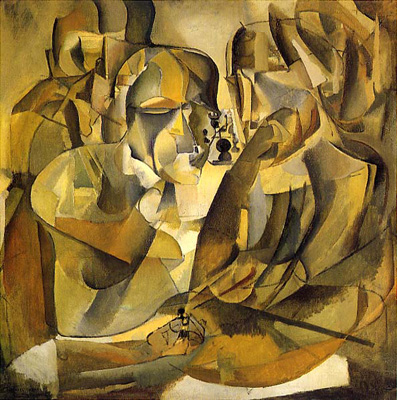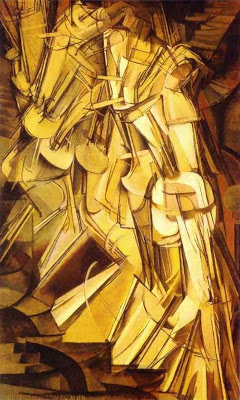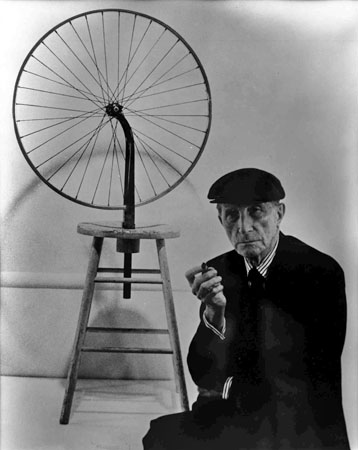Marcel Duchamp can be described as an author, sculptor, and painter
(1887-1968).
In 1904, Duchamp joined his two brothers, Jacques
Villon and Raymond
Duchamp-Villon, in Paris, where he studied painting until
1905. His earlier works were Post-Impressionist style. During the
year 1911 his painting became directed more towards Cubism. Nude
Descending a Staircase was shown at the Salon
díOr in 1912. Duchamp's radical style preceded the founding
of the Dada form of art around 1913. Dadaism
was an art movement based on deliberate irrationality and negation
of traditional artistic values. He also used Surrealist and Cubist
forms of art, using imagery produced by unnatural juxtapositions and
abstract structure in form of fragmenting his objects. His artwork
was often humorous and had no boundaries. Duchamp joined his brothers
at an art academy in Paris. This is when Cezanne, Symbolism, Fauvism,
Cubism, and popular illustration first influenced him. The Chess
Players, Nude Descending a staircase, and The King and the
Queen Surrounded by Swift Nudes are only three of his spectacular
paintings which used the Cubism art form. He used Cubist techniques
around 1904-1912.
 The Chess Players
The Chess Players |
 Nude Descending a Staircase
Nude Descending a Staircase |
 The King and the Queen Surrounded by Swift Nudes
The King and the Queen Surrounded by Swift Nudes
|
In 1912, he devised a Cubist-inspired technique for depicting motion.
He later became an abstract painter. Nude Descending a Staircase
was an artwork which was constructed using Cubist inspiration. He
constructed this work only with abstract lines and planes to exhibit
the womanís/mans motion. Soon after its completion Nude Descending
a Staircase was rejected by the Salon
des Independants because they felt Duchamp was making fun
of the Cubist form of art.
Another painting that soon followed Nude Descending
a Staircase was The King and Queen Surrounded by Swift Nudes.
This also resembled a type of abstract art, which has motion. Duchamp
said the swift nudes were "flights of imagination".
As Duchamp continued to work on other paintings he slowly departed
from Cubism and took another direction towards abstract art. His painting
The Passage from Virgin to Bride completely parted him form
his Cubist ties and took on a new abstract form.
He used a very different technique to put together one of his main
works, The Bride Stripped Bare by Her Bachelors, Even, which
put together a few of his smaller pieces of artworks, paint, lead
wire, mirror plating, foil and dust.
It really is not a painting at all, yet two large pieces of glass,
one on top of the other with different images.
 The Bride Stripped Bare by Her Bachelors, Even
The Bride Stripped Bare by Her Bachelors, Even
|
The Bride Stripped Bare by
Her Bachelors, Even was a monumental work done in 1923;
Duchamp included within it several mini paintings: one in particular
is the "Chocolate Grinder".
|
 The Chocolate Grinder
The Chocolate Grinder
|
|
It was a three-dimensional piece done with precision.
Another painting which was included was "Network of
Stoppages", which was a combination of three different
images. One image was nine lines all connected, traced from
three stoppages. The second image was an uncompleted version
of Young Man and Girl in Spring, which was a painting
done in 1910 and was rotated 90 degrees for the purpose of Duchamp's
work. The final piece was the background sketch of The Bride
Stripped Bare by Her Bachelors, Even which is rotated sideways.
Young Man and Girl in Spring is an allegory of union
of male and female, as is Bride Stripped Bare by Her Bachelors,
Even. The network of nine connected lines is a metaphor
for the connection between the two works. Duchamp threw in other
little displays of art in this piece also.
Duchamp worked on The Bride Stripped Bare By Her Bachelors
for many years, eight in fact. In 1923 he no longer worked on
it, calling it "definitely unfinished". A few
years later the "The Large Glass", as called
for short, was being shipped to a museum and broke into many
pieces. Duchamp found that he actually admired the work more
under these conditions, compared to its original state.
The Large Glass is not a work that is easily understood
at first. To understand the work the viewer must know that each
object is mobile, not static, and that it represents many intangible
objects. Duchamp chose objects with symbolic purpose to them.
Each symbolic object interacts with another. The Large Glass
depicts a series of actions. The work is comprised of two different
sheets of glass, each with individual actions taking place.
|
|
The top portion of Duchamp's The Large Glass has an
object representing the bride and the bridesí halo. The top
sequence can describe the courtship of a bride by her suitors.
This upper half of glass is used to depict the brideís domain.
The top portion of glass also connects in action with the lower
section of glass.
The lower half of The Large Glass
depicts the actions of the brideís suitors. In Duchamp's notes
he labeled the parts Glider containing a waterwheel, scissors,
mandala, eyewitness, and a chocolate grinder. This whole lower
glass represents the interaction of chance and predestination.
The connection between the top and lower half to this work is
open for interpretation. Since Duchamp left this work unfinished
the connection may never be known. Some may say it is symbolic
for sexual intercourse between a bride and her suitors, others
may say it is an exchange of wedding vows, or maybe even an
exchange of flirty glares. This lower half of the glass is the
bachelorís realm. One of the many parts to the bottom half include
the glider with the water well in it. It moves side to side,
representing the unpredictability and chance of fate. The water
well inside is connected to the chocolate grinder by rotary
motions. The chocolate grinder is connected on top by scissors.
The scissors represent the dangers of random forces of fate.
The mandala is a peephole, which in actuality reveals nothing
because The Large Glass is an abstract realm, invisible
to the eye. These are the many parts included in the lower portion
of The Large Glass.
|
| The bride in The Large Glass is not only
stripped bare but stripped down to her inner self, revealing her
aspirations and inspirations. Her halo, also shown on the upper
half of The Large Glass, represents her aspirations. Therefore,
it is represented in balloon shape, similar to a cartoon whose
thoughts are written out in this manner. In the halo resides three
nets which is the target to be fulfilled by a successful suitor.
To begin the "story" of the work the bride releases
an invisible "love gasoline" onto each suitor.
The vapors symbolize the brides love impulse. The bachelor(s)
are stimulated by the vapors and gas forms within the bachelor
molds. Then, the gas is conducted into capillary tubes (the nine
connected lines). After this it is moved into sieves which is
one of the parts of The Large Glass which Duchamp was unable
to complete. From here a butterfly pump, an element also imagined
by Duchamp, collected the gas where it was liquefied. From the
butterfly pump the now liquid gas was transported to a spiral
and then there is a "splash", which is sent to
the brides halo. As illustrated, The Large Glass is an
ongoing, yet uncompleted work by Duchamp. |
 |
|
Marcel Duchamp had other talents in addition to
being a painter, including making "ready-mades". Duchampís
"ready-mades" consisted of everyday objects,such as
a bicycle wheel, for example. In total, Duchamp created 21 bicycle
wheels, but the original was lost. His ready-mades were experiments
used to break the "tradition of art". His attempt
was to create a new kind of art which was different from the
norm. Another ready-made was his urinal, which is his most notorious,
entitled Fountain. Duchamp submitted Fountain as a prank
to avant grade art, meant to taunt his peers. For some this
was not funny because he tried to equate modern art with a urinal.
During the exhibition it was "misplaced" and
found soon after.
From 1915-1923 he incorporated much of his time
into The Bride Stripped Bare by Her Bachelors, Even and
his ready-mades. Even though Duchamp was excellent at his work
as an artist, in 1923 he moved back to Paris where he seemed
to have abandoned his love for art for his newfound love for
chess. Duchamp settled permanently in New York in 1942. He died
on October 2, 1968.
|
|
Marcel is a very unique artist
who brings a new sense and train of thought to art. His artwork
requires his viewers to use their mind and imagination rather
than just their eyes. He brings a new meaning to art by allowing
art to take many forms. His ready-mades, for example, were not
traditional pieces of art. His ready-mades actually shocked
people by him equating the object to modern art. Today, however,
many forms of art occur, of which Duchamp is a great influence.
Marcel Duchamp is a true inspiration also because he is not
a perfectionist. He allows his work to come out the way it does.
For example, The Large Glass broke as it was being exhibited
in a museum and he glued the pieces back together. His creation
appeared different, yet he turned out to like it even more than
before. Duchampís goal was to shift emphasis from the final
product to the artistís intentions. His legacy includes insight
that art can be about ideas instead of traditional objects.
He is a true inspiration to generations of artists to come.
|
References
http://www.beatmuseum.org/duchamp/marcelduchamp.html
http://www.mnstate.edu/gracyk/courses/phil%20of%20art/duchamp3.htm
http://www.understandingduchamp.com
http://www.marcelduchamp.org
|





